| |
| 
To hunt other flying insects, dragonflies
rely on their excellent vision and superb flight skills.
Their other senses are poor. Dragonflies, and many other
kinds of insects, have no sense of hearing. The antennae
of many insects are large and packed with chemical receptors
giving them superb senses of smell, taste and touch, but
a dragonfly’s antennae are small and their main function
is to measure air speed in flight. |
| 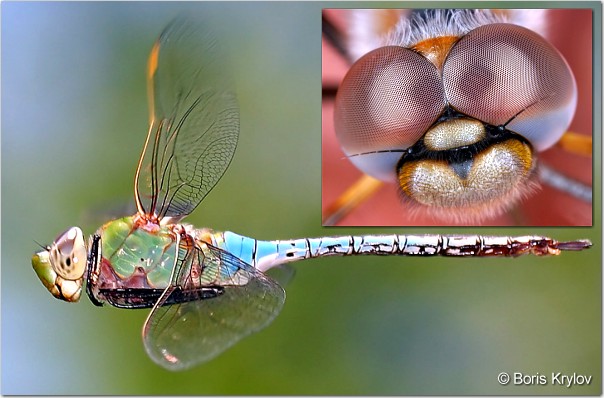
|  The
word "dragon" comes from an ancient Greek word meaning
"sharp-sighted one". The
word "dragon" comes from an ancient Greek word meaning
"sharp-sighted one".
|
 
The compound eyes of a dragonfly are huge
compared with the size of its head. (If you were a dragonfly,
your eyes would be the size of a football helmet!) Each
eye is made up of 30,000 telescope-shaped ommatidia (singular
= ommatidium). Each one collects light from the direction
it points, and the brain processes this to make a nearly
360 degree field of view. 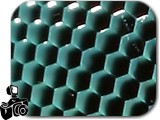 Compound
eyes cannot change focus, like human eyes, so only objects
that are close to the dragonfly appear in
clear detail. A dragonfly doesn’t see as much detail
as a human can, but its eyes and brain are extremely sensitive
to motion. They can detect movements separated by 1/300th
of a second! To a dragonfly, a movie might look like a series
of still pictures. Compound
eyes cannot change focus, like human eyes, so only objects
that are close to the dragonfly appear in
clear detail. A dragonfly doesn’t see as much detail
as a human can, but its eyes and brain are extremely sensitive
to motion. They can detect movements separated by 1/300th
of a second! To a dragonfly, a movie might look like a series
of still pictures. |
|  Dragonflies
have binocular vision, so they can judge distances. They
have colour vision, but see from orange to ultraviolet (UV)
light. Insects don’t see red light, while we humans
can’t see UV light. An object that reflects UV can
appear quite different to an insect than it would to our
eyes. Dragonflies also sense light polarization. Sunlight
scattering in the atmosphere or reflecting off water becomes
polarized. That means, instead of being randomly aligned,
the light waves tend to line up. This creates patterns in
the sky that show directions, and makes water surfaces highly
visible. Dragonflies
have binocular vision, so they can judge distances. They
have colour vision, but see from orange to ultraviolet (UV)
light. Insects don’t see red light, while we humans
can’t see UV light. An object that reflects UV can
appear quite different to an insect than it would to our
eyes. Dragonflies also sense light polarization. Sunlight
scattering in the atmosphere or reflecting off water becomes
polarized. That means, instead of being randomly aligned,
the light waves tend to line up. This creates patterns in
the sky that show directions, and makes water surfaces highly
visible.
|  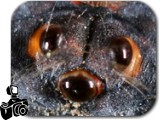 A
dragonfly's ocelli, or simple eyes, are very sensitive
to light intensity. They may be involved in determining
night from day, and regulating circadian rhythms. A
dragonfly's ocelli, or simple eyes, are very sensitive
to light intensity. They may be involved in determining
night from day, and regulating circadian rhythms.
|
|
| 
 Dragonflies
may be the best fliers on Earth. They can fly forward, backward
and turn almost instantly. They can hover, turn while hovering
and accelerate to full speed in a split second, then glide
effortlessly. Mated pairs can even fly together in tandem.
Imagine tethering two helicopters together and trying to
fly them! Dragonflies
may be the best fliers on Earth. They can fly forward, backward
and turn almost instantly. They can hover, turn while hovering
and accelerate to full speed in a split second, then glide
effortlessly. Mated pairs can even fly together in tandem.
Imagine tethering two helicopters together and trying to
fly them!
|
|  Dragonflies are among the swiftest
flying insects, proven to reach air speeds of 38 Km/h.
Dragonflies are among the swiftest
flying insects, proven to reach air speeds of 38 Km/h.
|
Each of a dragonfly’s wings operates
independently, providing great maneuverability. They are
powered by direct muscle action, the flight muscles are
anchored directly to the ends of the wings. Most flying
insects, like butterflies, flies and bees, have indirect
flight muscles, which change the shape of the thorax to
power the wings. Dragonfly wings beat about 30 times/second,
which is slow compared to some insects with indirect flight
muscles. Mosquito wings beat 300 times/s.
| 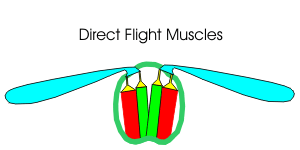
In "direct flight"
the muscles that raise (green) and lower (red) the
wings are both attached to the end of the wing and
the bottom of the thorax. |
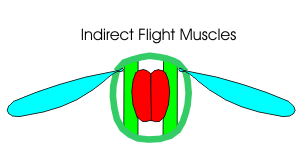 In "indirect
flight" the muscles that raise (green) the
wing are attached to the top and bottom of the thorax,
while those that lower (red, in cross section) the
wings are attached at the front and back of the
thorax. In "indirect
flight" the muscles that raise (green) the
wing are attached to the top and bottom of the thorax,
while those that lower (red, in cross section) the
wings are attached at the front and back of the
thorax.
|
|
| Active flight uses a lot
of energy. A flying dragonfly uses 100 times more energy
than one at rest. Some dragonflies must eat about 20% of
their body weight a day just to power their flight. A “fully
fueled” dragonfly can only fly for 8 hr before exhausting
its reserves of fat. |
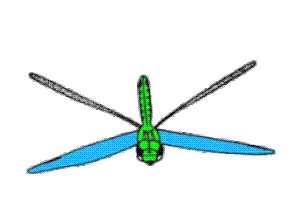
The wing actions, in slow
motion,
of a dragonfly hovering. (Rear wings in blue.) |
| |
| 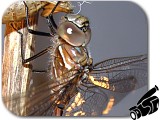
A "shivering"
dragonfly.
(Video = 30 sec., 0.9 Mb) |
Dragonflies must be
warm to fly. Temperature in the thorax must be over
25 C. Most species are active during the day and bask
in the sun to warm up. Some large dragonflies generate
heat by shivering their flight muscles before takeoff.
This allows them to fly early in
the morning or at dusk. |
| |
Watch a higher resolution version of this video on YouTube. Click Here: Shivering! |
| |
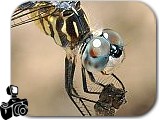 On
hot, sunny days a dragonfly can get too warm. Active flight
generates a lot of heat. To cool itself it can stop flying
and roost in the shade. If no shade is available it will
sit with its abdomen pointing at the sun (called the "obelisk
position") to reduce solar heating. Some dragonflies
will even dip their bodies into water as they fly to promote
evaporative cooling. On
hot, sunny days a dragonfly can get too warm. Active flight
generates a lot of heat. To cool itself it can stop flying
and roost in the shade. If no shade is available it will
sit with its abdomen pointing at the sun (called the "obelisk
position") to reduce solar heating. Some dragonflies
will even dip their bodies into water as they fly to promote
evaporative cooling.
|
|  When
not hunting, at night and during bad weather, dragonflies
perch under leaves or other shelter. When
not hunting, at night and during bad weather, dragonflies
perch under leaves or other shelter.
|
|
|
| 
Fly back to NatureNorth.com |
|
| |
|